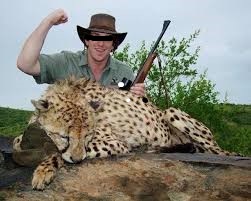|

African cheetahs are considered “vulnerable” by the IUCN with a downward trend of population numbers. The US Fish and Wildlife Service has placed cheetahs on their “endangered” list, meaning that USA hunters cannot import cheetah trophies. CITES, while listing cheetahs on their Appendix I (no commercial trade) ignores that trophy hunting is a commercial activity and extends a yearly quota of 150 cheetahs to Namibia (live and trophy hunting exports) and 5 to Botswana in the same category. The EU, strangely, still allows imports of cheetah hunting trophies, and that is where the stuffed carcasses of trophy hunted cheetahs mainly end up.
A recent publication estimated 3,577 cheetahs across southern Africa and that >75% of the species’ range exists outside protected areas where cheetahs may be exposed to high levels of threat from human persecution. The highest percentage of this southern African population live in Namibia (55.6% of suitable cheetah habitat in southern Africa).
Extrapolating, we could roughly assume that Namibia contains on the order of 2,000 cheetahs, and that as many as 1,500 of those could occur on some form of agricultural land. There has been no comprehensive survey of cheetahs in Namibia to date. Survival of cheetahs in Namibia therefore depends, worryingly, on populations that occur on private and extensive “farmlands”.
The cheetah population study referenced below indicated that during the 4-6 years of their study, on Namibian farms (n = 185 surveyed), 26.5% of land managers actively persecuted cheetahs while 49.7% considered the species as causing conflict. On those properties, managers trapped a total of 245 cheetahs during the survey period, of which 17 were translocated, 32 were placed into permanent captivity, and 196 were killed.
A massive mortality.
The foremost cheetah conservation organization in Namibia has embraced trophy hunting. Their reasoning – if farmers are allowed to earn revenue from trophy hunting they could tolerate cheetahs on their land, but this is hardly a sustainable solution.
But in addition to the “conflict killings”, CITES trade records indicate that in the five years 2015 to 2019 (records for 2019 are not yet complete) Namibia exported 436 cheetahs in the “trophy hunting” categories. Trophies went mainly to Russia, Mexico, and the EU – Hungary, France, Spain, Germany, Czech Republic, Austria.
Meaning that over a period of five years (farm conflict and trophy hunting combined, 2012-2016) Namibia lost a total of 734 cheetahs, heavily weighed to male cheetahs (all hunting trophies, most farm captures/killings).
And yet Namibia is awarded 150 wild cheetahs by CITES per year based on no “sustainable” possibility.
Whatever current justifications given for trophy hunting of a near-endangered big cat species, the offtake for commercial purposes in Namibia needs careful examination and transparency. Like – how much profit are trophy hunting operators taking versus sharing with the farmers on whose lands they take clients? And legally, do those cheetahs, as wildlife, actually belong to the farmers who sell trophy hunting opportunities? Could other compensations be made available to farmers to promote cheetah conservation other than trophy hunting and “problem animal” trapping and killing?
And why does the EU allow trophy hunting imports of a species categorized by the IUCN as vulnerable and decreasing in numbers, listed on CITES Appendix I and on the USA endangered species list? Surely the EU must have the same information as the USA, so why the unexplained divergence in allowing trophy hunting imports?
https://peerj.com/articles/4096.pdf
|




